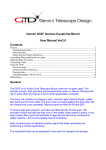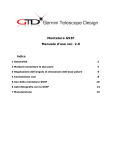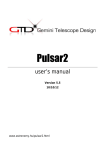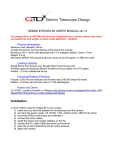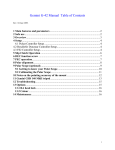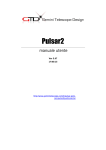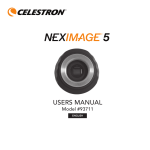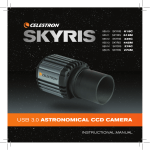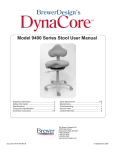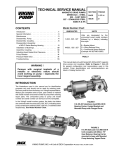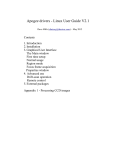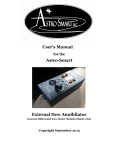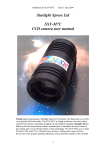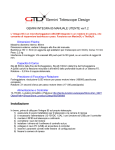Download G53F User`s Manual 2.0 - Gemini Telescope Design
Transcript
Gemini G53F German Equatorial Mount User Manual Ver2.1 Contents General.................................................................................................................................................1 Technical parameters.......................................................................................................................2 Delivered Parts.................................................................................................................................2 Mount specific Pulsar2 parameters..................................................................................................2 Assembling/Disassembling the two parts.............................................................................................3 Adjusting Polar Elevation.....................................................................................................................4 Connecting Cables................................................................................................................................6 Using the G53F.....................................................................................................................................7 First time setup.................................................................................................................................8 Absolute Position Reference............................................................................................................9 Practical hints...................................................................................................................................9 Astrophotography with the G53F..................................................................................................10 Maintenance........................................................................................................................................11 General The G53F is a Friction Drive Telescope Mount, there are no gears used. This ensures smooth, high precision and backlash free motion in silence. Moving parts roll on each other (not slip as a worm) which guarantees a long life. The drive unit consists of a stepper motor, reduction gear (Gemini Fluido) and the drive roller. The drive roller is pushed against the drive disk with the torque limited clutch knob. Identical parts are fitted to RA and DEC. To ensure high goto precison, encoders are fitted directly to both axes. The encoders correct any slip that may occur if the drive slips or clutches are opened. If you hear a beep after a goto that indicates a large slip that will not be corrected for safety reasons – the mount probably has hit something. Both encoders have an absolute position signal that helps recovering lost positioning in remote applications. The equatorial head can be separated in two parts for transport and storage. Technical parameters Steppers: NEMA 17, 400 step, 1,5 Amp Drive disk: D 220 mm, stainless steel Drive roller: D 6 mm, hardened and coated steel Encoders: Optical incremental, 72 000 pulse/rev Weight: 20 kg Load capacity: 45 kg Maximum unbalanced torque: 10 Nm (1kg at 1m radius) Elevation range: 25-90 deg Temperature range: -20 to +30 Driver: Pulsar2 Slewing precision: cca +/- 30 arcsec Max slewing speed with Pulsar2. 4 deg/sec Tracking precision: 2”/5 minutes Power: 12-18VDC, 3A (1A continuous draw at 12V) Telescope interface: Losmandy rail or custom Delivered Parts Equatorial head with Losmandy adapter, Counterweight shaft (30mm), Pulsar2 driver with hand controller, motor cables, encoder cables, power cable with banana plug, cable guide ring. Optional: counterweights, polar finder, tripod. Mount specific Pulsar2 parameters (Non default values only) Total Red: enter 360, the exact value will be calculated by Pulsar2 Track current: 950mA GoTo current: 1200mA Stop current: 400mA or 950 for guided photography Motor step R/D: 400 Encoders: Mount encoders are fitted (answer Yes to Mount encoder RA and DEC, answer No to Motor encoder RA and DEC) Resolution: 72 000 both RA and DEC Rotation: leave as it is, will be defined by Pulsar2 Umod Sp limit (user parameters) 9900 Ramp (user parameters) Ra 1, Dec 2 Backlash (user parameters):0 arcsec There are videos on YouTube to help with the setup and other features. Visit this link to see the updated list: http://www.geminitelescope.com/manuals.html Assembling/Disassembling the two parts 1 To assemble the equatorial head get ready the parts shown below and the DEC head. (the 6mm hex key is not delivered) 2 Now place the DEC head into the red saddle as shown below. You can conveniently hold it with your right hand by reaching into the counterweight shaft hole. Note the position of the DEC drive unit! (opposing the Ra drive) 3 Put the upper saddle half on the DEC head so that the holes face those in the lower saddle. 4 Fasten the screws evenly, making sure that the gap between the two saddle parts is approximately equal on either side. This will have importance if you put a polar finder on top of the upper saddle. You are ready now. Disassembling is the reverse of assembling. Adjusting Polar Elevation The adjustment range of the elevation screw is cca 20 degrees. If you need more adjustment you have to reposition the RA head in the elevation plates as explained below. 1 Remove the DEC head from the RA head. This makes the procedure much more easy to do. 2 Turn the elevation screw close to the OUT position. 3 Remove both elevation locks and the centering rings which are below the locks. 4 Pull out backwards the RA head from the fork base. 5 The pin is marked with a blue dot. You must pull the plates away and put the pins into the correct holes (1 to 4) for your desired latitude. The actual position (2) is for mid Northern/Southern latitudes, 1 is down to 25 deg, 3 and 4 for far North/South. 6 Push the RA head back into the fork base, insert the centering rings and the locks, finally mount the DEC head. 1 turn of the elevation screw is cca 0,6 degree change in elevation. Connecting Cables You need to connect 3 cables from Pulsar2 to G53F (4 terminals at mount end). There is a video tutorial also, the link is on our webpage. Motor cable (1) (DB15 at Pulsar2 end, 2x 4/4 telephone plug at G53F end) The shorter cable is RA, the longer DEC. Encoder cables (2) (8/8 UTP at Pulsar2 end, 5pin Tuhel plug at G53F end) The shorter cable is RA, the longer DEC (only the length is different). No damage will occur if you swap the cables but the mount will not operate correctly. DEC and RA encoder connectors DEC and Ra motor connectors Using the G53F First time setup If you are using the G53F for the first time or have replaced the Pulsar2 controller check the Mount Parameters in Pulsar2 (and see also the P2 manual). Check if the mount tracks westward, if not change the Rotation (mount parameters menu)! If all is correct you will want to do the automatic setup process which calculates the total reduction and the encoder direction. Insert the counterweight shaft and lock the axes by turning both control knobs right until you feel strong resistance (cca ½ turn after feeling the build-up of resistance). The mount is well balanced with the counterweight shaft, remove any load from the telescope platform. Correct position for running Red autoset Enter the Mount Parameters menu, Red (uction) autoset submenu and start the process. The mount will start rotating slowly cca 45 degrees and back in both axes. You will have to acknowledge by a right click the calculated values. (slip factor and reduction). For the slip factor you should get a value above 98%, if it is much lower the balance is off. When finished, exit the menu, the controller is ready for use. For loading counterweights and telescopes leave the RA axis open, close the DEC by turning the DEC control knob right until you hear a click. For balancing release both axes with the control knob. Try to get a good balance! When balanced, lock both control knobs by turning them right until you hear a click. Absolute Position Reference The G53F when used with Pulsar2 can memorize the absolute position signal of the encoders (sent once in every full rotation of the axes) and use this as a reference for initializing the mount. You still need to be polar aligned and have time (UT) and lat/long (in decimals) set correctly. With this feature you can initialize the G53F remotely, using only an IP camera as your „eyes”. Select the Set Reference submenu in Mount Parameters and follow the instructions. You need to have the mount initialized on a star beforehand.You are asked to slew the mount until the signal has been recieved. The RA absolute signal is factory adjusted to fall within 2 hours of the meridian with the OTA on the Western side. If you do not find the reference on the Western side reverse the dec head in the red saddle! In Declination the absolute signal is in the zone of cca -10/+30 deg. This will allow a safe and convenient initializing when needed. Note that the Losmandy lock handknobs must face upwards for the reference to fall in the above zone. To initialize the G53F with the encoders go to the Get Reference submenu in the User Parameters menu and slew the mount into the above mentioned positions as promted by the hand controller. Reaching the signal is acknowledged by a beep and the slew stops automaticly Practical hints You can open the axes while the mount is in use and rotate the telescope by hand but if you do fast movements positioning will partially be lost. If the mount hits something the integrated slip clutches will protect the drive system and the telescope from damage. If a goto fails for the above reason you will hear a beep and there will be no correction. The coordinates will stay correct. If the control knobs are lightly locked the drive rollers may slip which eventually may damage them. To avoid this either open the control knobs completely (1,5 turns left from locked position) or lock them fully as described above. The slewing speed depends on the load you have on the G53F. With a medium sized telescope (10” SC) you can use 999. For larger loads experiment with speed, Umod sp limit and ramp to get a reliable result (reduce speed Umod sp limit and ramp if necessary). Run the Red Autoset routine (Mount Parameters menu) if the ambient temperature has changed more than 15 deg C. This ensures the precise tracking rate. Before you look for other reasons of goto pointing errors check your polar alignment. If a 15 min unguided image above +60 deg declination shows no drift (less than 5 arcsec) you are ok. After Jan. 2013 the G53F is equipped with autolimiting friction control knobs. Just turn right the red knob until you hear the „click”! The mount is locked now. To unlock, turn left one turn. Astrophotography with the G53F There are a few things to remember for successful imaging. 1) use the correct guide speed for your pixel scale. E.g. Speed 1-2 for high resolution (up tp 1.5”/pixel), speed 3-4 for medium and 5 for telephoto imaging. 2) Have stop current set close to track current to avoid jumps in declination 3) Do not let any cables hang off the telescope or camera. Route them all via the center of the declination head, thru the supplied cable guide ring. 4) Balance the mount as precisely as possible. If you have a Newtonian orient the focusser exactly facing or opposing the telescope platform. All other positions will imbalance the telescope in some sky position. If you have a guidescope on the main tube the same is valid for that. 5) If you have to flip meridian make sure to select the correct direction in Pulsar2. Setup/User parameters/Pole crossing/Tube rotation. For Newtonians select North, for all other telescopes that have the camera at the lower end select South. This will prevent cable problems if you have routed them thru the provided ring. 6) The controller Pulsar2 connects to the computer either as an LX200 non GPS device or via the ASCOM platform and its dedicated driver. See www.geminitelescope.com/manuals.html for more help. It has been tested with MaxIm and Astroart. Do not use an autoguiding cable, connecting the mount via the serial/usb port gives more precise corrections. Maintenance The anodised aluminium surfaces will keep their gloss for a long time if treated regularly with paraffin oil or silicone oil. Use a soft cloth to disperse the oil on the surface. Protect the mount from dust, sand and dirt. If you see dirt on the drive disc, remove the plastic protection cap and wipe it off with a cotton tip. No maintenance of the drive system is necessary. For longer periods of cloudy nights and transport leave the axes disengaged. Innovation and service since 1996 www.geminitelescope.com











